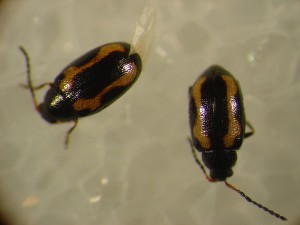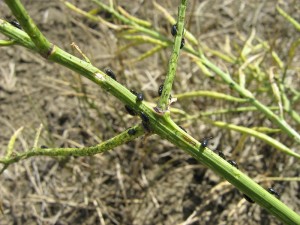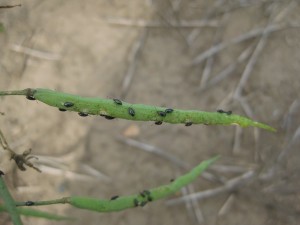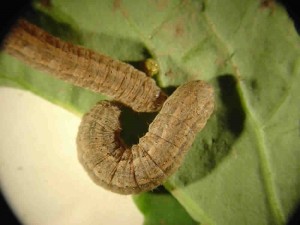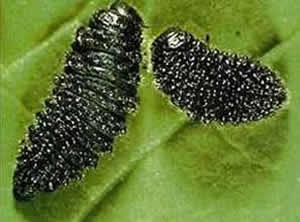Flea beetles – The main flea beetle species in Saskatchewan are crucifer (Phyllotreta cruciferae), striped (P. striolata) and hop (Psylliodes punctulata). Flea beetles overwinter as adults and emerge in the spring, feeding on the cotyledons, leaves, apical bud tissue and stems of mustard plants. In July, larvae feed on root hairs. Adults emerging later in the season may “de-bark” seed pods.
The effect on the crop varies with the intensity of pest pressure, the part of the plant where damage occurs and the growing conditions. Flea beetles are more active with higher temperatures. Seedlings are most susceptible to serious flea beetle damage. Damage is most severe when the beetles attack the growing point of the plant. In cool moist conditions, scouting should include observing the underside of cotyledons for pitting and the stem for notching or girdling. Feeding on pods can result in premature shattering and grade loss.
Management: Seed treatments containing an insecticide are an effective method for controlling flea beetles. Current seed treatments require the insect to consume plant tissue for control. Seed treatments have a limited time in which they are effective. If the seedlings are growing slowly or flea beetle pressure is high, a foliar insecticide spray may be required. An action threshold of 25 per cent cotyledon surface removed (Assessing leaf area loss to flea beetles can be found here) is the recommended level of damage when a spray may be necessary to protect the seedling.
Cutworms – There are various species of cutworms found in Saskatchewan including: redbacked cutworm (Euxoa ochrogaster) in eastern regions; pale western cutworm (Agrotis orthogonia) in western regions; dingy cutworm (Feltia jaculifera); and bristly cutworm (Lacinipolia renigera) among others. Cutworm moths lay eggs in late summer, usually August and September. The females tend to deposit eggs in areas with green growth (weedy or crop), preferably in loose soil. Some species overwinter as eggs and hatch in the spring. Other species overwinter as larvae and will commence feeding earlier in the spring than species that overwintered as eggs. Species that overwinter as larvae will usually start to pupate from mid to late June, depending on climatic conditions. Cutworms that overwinter as eggs commence pupation near the end of June or early July.
Cutworm larvae generally feed most actively during the evening, at night and the early morning. Feeding damage differs between species. Some, such as the red-backed cutworm, remain below ground cutting off plants at or below the soil surface, while others such as the dingy cutworm feed above ground on foliar vegetation. Due to the reclusive nature of cutworms, monitoring can be difficult. Once the presence of cutworms has been verified, per cent stand reduction can be used as an estimate of damage. Since there are other potential causes for reduced plant stands, the presence of cutworms should be determined by digging in the soil. The best results will be to look near the newest area of missing plants.
Management: A foliar insecticide spray should be considered when there is 25 to 30 per cent stand reduction. There is no good predictive model for cutworm infestations and populations can be variable from year to year. There is also a seed treatment registered for cutworm control in mustard (see Production > Seed treatment). A resource published in spring of 2017 by Agriculture & Agri-Food Canada provides in-depth information about identification and management of cutworms on the Prairies. A downloadable version is available at: https://drive.google.com/file/d/0B_Pg-Nb5Pst1VnFuZk1hb25ZWk0/view
Red turnip beetle (Entomoscelis americana) - Red turnip beetle is an occasional pest of mustard in Saskatchewan. The adults are 7 to 10 mm long and easily distinguished by bright red bodies marked with black patches just behind the head and three distinct, black stripes running down the wing coverings. Eggs are deposited from early August to late October near the plants on which the adult beetles feed. Eggs remain dormant until late March to early May. Hatching occurs in the spring. The larvae are smoky black on top and brownish underneath. Larval development takes three to four weeks depending on climatic conditions and is normally completed by the end of May.
In May and June, infestations of both larvae and adults move into mustard crops, often from stubble fields of cruciferous crops (canola, rapeseed or mustard) or areas containing heavy stands of weeds of the mustard family. Crop damage usually occurs along field margins but may occur in patches throughout the crop if cruciferous volunteers were previously present. The larvae and adults feed on the cotyledons, true leaves, petioles and stems of the seedlings. Depending on the size of the plants and beetle populations, damage will vary from minor feeding on cotyledons and true leaves to complete defoliation, especially with seedlings. The late summer adults are not usually economically important.
Management: Red turnip beetle infestations can be reduced considerably through cultivation. Fall cultivation will bury eggs. Newly hatched larvae do not move well in the soil and burying the eggs can result in 75 to 100 per cent mortality of larvae the following spring.
Weed control, whether by cultivation or chemical methods, will indirectly control the larvae by destroying their food source.
Currently there are no insecticides registered for control of the red turnip beetle.
< Previous: Pest Control: Insects: Insect scouting
> Next: Pest Control: Insects: Pests at flowering and podding stages
